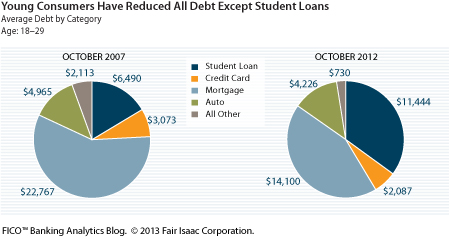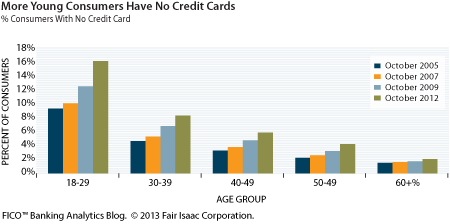The Young and the Cardless
My admittedly kitschy title highlights a new trend that we’ve observed after analyzing credit behaviors across different age groups: more young consumers are forgoing the use of cr…

My admittedly kitschy title highlights a new trend that we’ve observed after analyzing credit behaviors across different age groups: more young consumers are forgoing the use of credit cards.
First, let’s look at a breakdown of outstanding debt for consumers in the 18-29 age group between October 2007 and October 2012. Except for student loan debt, these consumers have reduced their outstanding debt across all categories.
While the growth in student loan debt garners a lot of attention, the fairly dramatic reduction in credit card debt is also enormously noteworthy. Lower credit card debt is not only associated with consumers carrying lower balances on their cards, but more consumers not having any credit cards in general.
As the chart above illustrates, over time there’s been an increasing number of consumers within each age group that no longer have a credit card. This change is most dramatic among younger consumers.
This trend can be attributed to two main influences. First, the CARD Act has put more requirements on issuers before a card can be issued. In order to open a credit card account, for example, consumers under 21 need to show an ability to pay off the debt or have a co-signer on the card.
Secondly, the impact of the recession seems to have had a pronounced effect on young consumers’ attitudes toward credit. These results are consistent with reports indicating that younger consumers are more likely to use debit cards instead of credit cards for purchases. They may also reflect the growing use of mobile payments by this younger generation.
As more young consumers eschew credit, credit card issuers may need to rethink established lending strategies for attracting and building relationships with these consumers. As part of that, issuers may benefit from supplementing traditional credit data with new data sources to develop more refined marketing and risk management tools for this dynamic demographic group. This will allow them to grow their portfolio responsibly and stay relevant in an increasingly competitive and changing landscape.
Popular Posts

Business and IT Alignment is Critical to Your AI Success
These are the five pillars that can unite business and IT goals and convert artificial intelligence into measurable value — fast
Read more
It’s 2021. Do You Know What Your AI Is Doing?
New "State of Responsible AI" report from Corinium and FICO finds that most companies don’t—and are deploying artificial intelligence at significant risk
Read more
FICO® Score 10T Decisively Beats VantageScore 4.0 on Predictability
An analysis by FICO data scientists has found that FICO Score 10T significantly outperforms VantageScore 4.0 in mortgage origination predictive power.
Read moreTake the next step
Connect with FICO for answers to all your product and solution questions. Interested in becoming a business partner? Contact us to learn more. We look forward to hearing from you.


